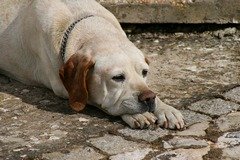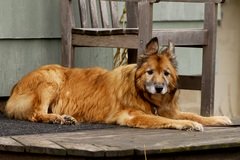|
Recognising the signs of an elderly dog
There are many signs of an elderly dog. Most occur gradually with the passage of time and can be observed by the older dogs owner. Becoming aware of the signs of aging in your dog can be very beneficial. For example, it could help you to recognise the onset of a particular health condition of which early treatment could help to stop the condition from worsening, or at least slow it down such as arthritis. It could also help you to understand the difference between what is a normal sign of aging and what could be something more serious. Some of the signs of an elderly dog are physical signs and some are behavioural but one thing is common for both of them - a general slowing down. It has been found that in a young dog messages travel along the nervous system at about 6000m per second but in the elderly dog this slows to about 1300m per second. This along with arthritis can make a noticeable difference to your dog and is the biggest change that I have noticed in my own old dog, Pippa. When she was young she was extremely quick in every way but now her responses are much slower. One of the first physical signs of an elderly dog is the graying of hairs around the muzzle and flecks in the rest of the dogs coat, especially around the collar. This can be followed by noticing that your dogs joints are beginning to stiffen up due to arthritis, especially in the morning or after they have been lying down for a length of time. Your dog might begin to struggle to get up the stairs or jump up. One of the first signs I noticed with my dog was that she started to struggle to jump onto our bed and the sofa. Now she no longer manages it at all. Sleep becomes a much more common pastime which together along with hearing loss can make your once alert guard dog become a very poor one! We now find that we can walk into our house and Pip will be fast asleep somewhere oblivious to our entrance. This never use to happen. If she does wake up she often can't be bothered to get off her cosy bed! It is a similar story in the morning when I get up from a nights sleep. When Pip was younger she would be there waiting excitedly, tail wagging furiously, ready to go out for a walk. Now she rarely bothers to get off her bed when I come down.
You may find your dog tires more on walks and lags behind. I found that my dog Pippa now lags behind and I have to sometimes shout and encourage her to keep with me. This can be an area of concern because of another sign - mental confusion in the old dog and the fact that they could get disoriented and lost if you are not careful.

Your dog might seek more time on her own away from everyone else. I have noticed this with my children and Pippa, especially if they are being noisy which is why I ask them not to go anywhere near her bed and to give her space when she is resting.
Your dog may gain weight more easily because its dietary needs have changed. This in turn can make arthritis worse because of the extra weight they are carrying. An old dog requires less calories with special nutrients and should be fed a senior dog food which reflects this.
Older dogs eyes take on a distinct older look in general just like humans do and their eyes reflect light more at night. This is due to changes in the eye as they age. Their near vision can often deteriorate but their long vision usually remains excellent.
Sometimes the senior dog may have incontinence issues. You might notice that your dog has pooped or urinated in the house which seems out of character. They may want to be let out of the house more frequently to go to the toilet.
One sign of an elderly dog to watch out for is an increased thirst. This can mean the early onset of diabetes and should always be investigated as soon as possible by a qualified vet.
You might notice that your old dog starts to get confused sometimes. Sometimes they might bark at things that they have never bothered about before, get a bit lost with familiar directions or try and exit through a door at the wrong side.
Your old dog may also start to pant more, especially in hot weather as they find it harder to regulate their body temperature. Likewise in winter they can feel the cold more, especially if they have a short coat, and can benefit from a special dog coat. Additionally, regarding panting, I have found that it can be a sign that my old dog is in pain when she pants. This is not panting when she has been exercising or is hot. It is usually when she gets up to move after lying down for a length of time and her joints obviously pain her.
These are just a few of the more common signs of an elderly dog that can be noticed. Only you know your dog as well as you do and I am sure there will be others that you will notice too.
Click here to return from Recognising the signs of an elderly dog to My old dog homepage
|



